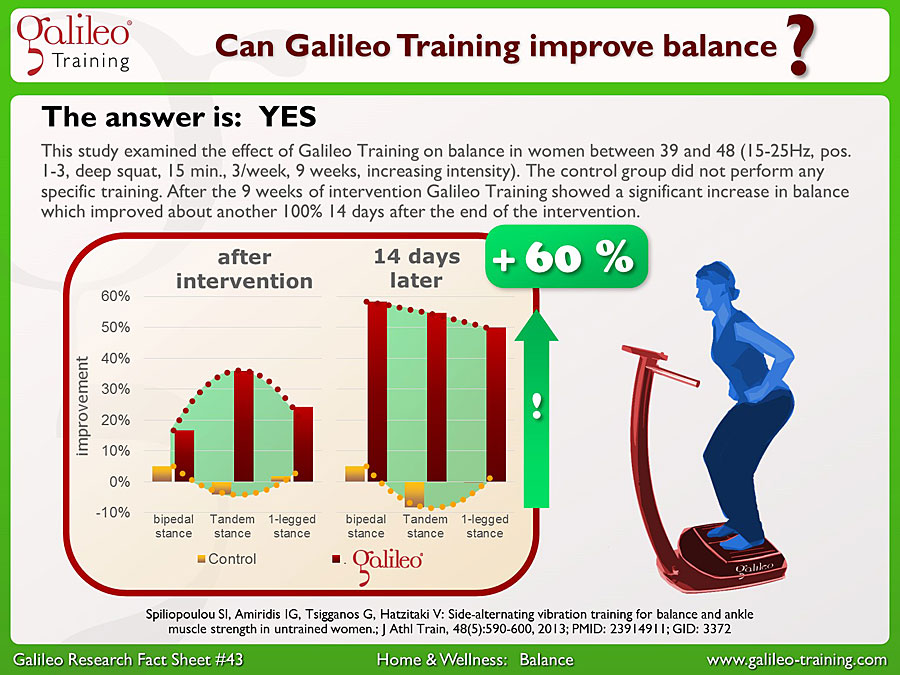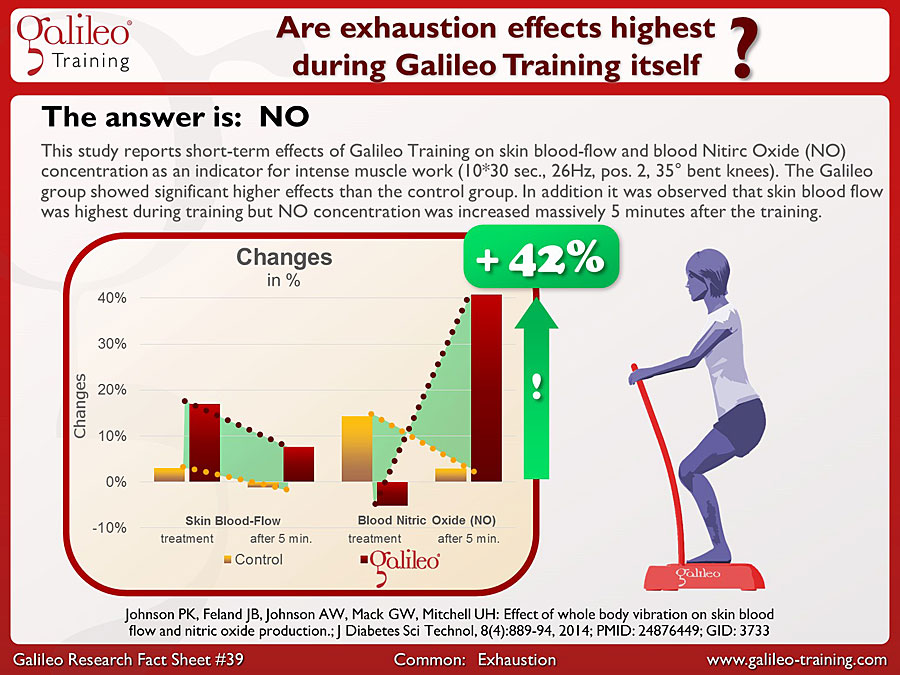The first Galileo Space-Study examined its effects on muscle and bone mass in simulated weightlessness (55 days bedrest, 10 min., 5 days/week 12-26Hz). The control group did not have any training. While the control group showed massive loss of bone mass (over 15%) the Galileo Group could almost completely compensate this effect (in strict bed-rest over 55 days!) and even showed higher bone mass (+4%) after 1 year follow-up...
Galileo Research Facts No. 44: Can Galileo Training in artificial weightlessness prevent loss of muscle and muscle function?
The first Galileo Space-Study examined its effects on muscle and bone in simulated weightlessness (55 days bedrest, 10 min., 5 days/week 12-26Hz). The control group did not have any training. While the control group showed massive loss in muscle cross-section, the Galileo groups hardly lost any muscle and could even improve muscle function (max torque) by 12% (in strict bed-rest over 55 days without any other exercise!)...
Galileo Research Facts No. 43: Can Galileo Training improve balance?
This study examined the effect of Galileo Training on balance in women between 39 and 48 (15-25Hz, pos. 1-3, deep squat, 15 min., 3/week, 9 weeks, increasing intensity). The control group did not perform any specific training. After the 9 weeks of intervention Galileo Training showed a significant increase in balance which improved about another 100% 14 days after the end of the intervention...
Galileo Research Facts No. 39: Are exhaustion effects highest during Galileo Training itself?
This study reports short-term effects of Galileo Training on skin blood-flow and blood Nitirc Oxide (NO) concentration as an indicator for intense muscle work (10*30 sec., 26Hz, pos. 2, 35° bent knees). The Galileo group showed significant higher effects than the control group. In addition it was observed that skin blood flow was highest during training but NO concentration was increased massively 5 minutes after the training...
Galileo Research Facts No. 38: Can 75 seconds of Galileo warm-up training increase flexibility, performance and balance?
The study reported the immediate effects of 75 seconds of a special Galileo Based warm-up training on flexibility, jumping performance and balance in Olympic rhythmic gymnasts (5*15 sec., 30Hz, pos. 2). The control group did the same 5 exercises without vibration. The Galileo group showed immediately and 15 min. after the exercises improvements of up to 15% while the control groups showed no significant improvements...
Galileo Research Facts No. 35: Can Galileo Training increase jumping performance after only 10 days?
The first Whole Body Vibration Training study ever, done with Galileo in 1998. It shows the effects of Galileo Training on Jumping performance in active handball and water polo players (26Hz, pos. 5, 5*2 min., 10 days, 1) forefoot 2) 45° squat 3) 90°squat 4/5) 90°squat one legged). Both groups performed additional 20 min. warmup and 5 min. jump training. Only the Galileo Training group showed jump improvements of up to 12%...
Galileo Research Facts No. 33: Can one set Galileo Training + Blood Flow Restriction activate muscle Satellite cells?
This study reports short-term effects of Galileo Training on skin blood-flow and blood Nitirc Oxide (NO) concentration as an indicator for intense muscle work (10*30 sec., 26Hz, pos. 2, 35° bent knees). The Galileo group showed significant higher effects than the control group. In addition it was observed that skin blood flow was highest during training but NO concentration was increased massively 5 minutes after the training...
Galileo Research Facts No. 29: Can Galileo Training change muscle histology after only 12 training sessions?
This study shows the changes of muscle histology and muscle function using exhaustive Galileo Training for athletes (25Hz, 2 sets squats until exhaustion (max. 3 min.) with 40% (start) to 80% (end) body weight extra load, pos. 3-4, 2/week, 6 week). The Galileo group increase muscle fiber cross-section by 95% (Type 2) and 23% (Type 1) and the 1 Repetition Maximum (1RM) by 25% (from 111kg to 141kg)...
Galileo Research Facts No. 28: Can Galileo Training compensate the negative effects of HIT on anaerobic power?
This study used Galileo Training in rest phases between High Intensity Training (HIT) intervals to reduce loss of anaerobic power (20 Sessions HIT, HIT+18Hz/HIT+30Hz, 3 min., pos. 3, knees half bent). Galileo Training during rest phases could compensate the HIT associated loss of anaerobic power and MyHC-2x fiber cross-sectional area completely. Galileo Training at 18 Hz showed about 20% higher effects than training at 30Hz...
Galileo Info Sheet #1: Galileo Training Galileo Training Frequencies: Which frequency when and why?
Galileo Info Sheet #1: Galileo Training – Frequncy ranges and their apllications - What frequency is needed for which training goal?









